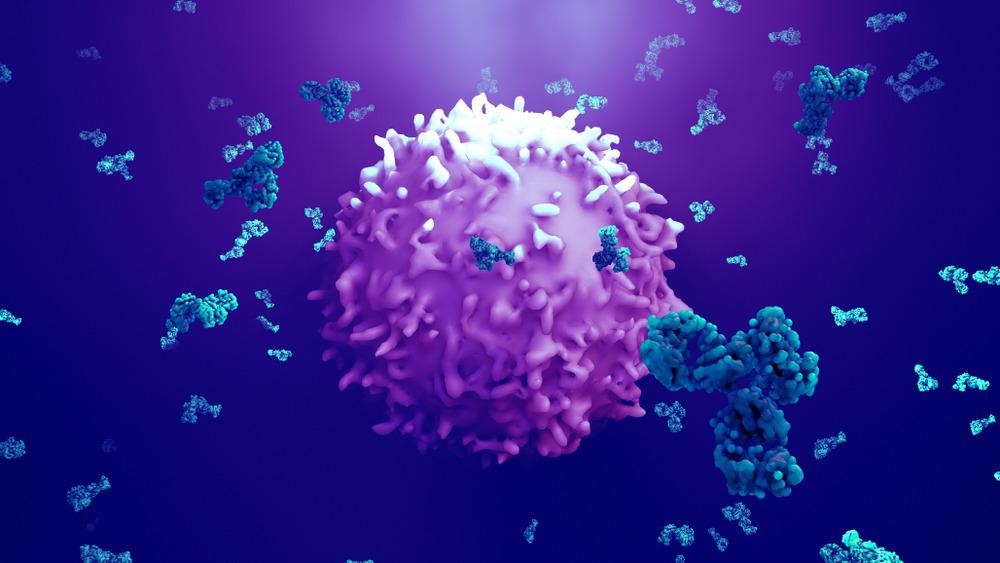A recent article published in the journal ACS Nano discusses the application of Escherichia coli (E. coli)-mimetic nanomaterials for photolytic treatment of CT-26 or 4T1 tumors.

Study: Mimetic Gold Nanorod-Mediated Photo- and Immunotherapy for Treating Cancer and Its Metastasis. Image Credit: Design_Cells/Shutterstock.com
The authors synthesized the target nanomaterials using E. coli membrane proteins, gold nanorods (AuNRs), and adhesion proteins and named them E. coli-mimetic AuNRs (ECA). Further, the synthesized ECA showed a preventive effect in mice with CT-26 or 4T1 tumors under 808-nanometer laser irradiations.
Metastasis or reoccurrence are the key reasons behind the increase in cancer mortality, and treating recurrent or metastatic cancers is the end goal of cancer therapy. Combination therapy is an effective treatment for metastasis and reoccurrence. Further, combining nanomaterial-based phototherapy with chemotherapy has a scope in cancer treatment.
Nanomaterials in Cancer Therapy
Selective treatment of cancer cells through immunotherapy involves activation of immune cells, especially T lymphocytes aiding in eliminating cancer by inducing antigen-specific cytotoxicity. In this context, the dendritic cells (DCs) activated T cells selectively destroy antigen-expressing cells in cancer treatment.
Photothermal therapy (PTT) used for localized cancer treatment involves light energy conversion into thermal energy upon irradiation with a near-infrared (NIR) laser.
Nanomaterials can carry drugs to specific targets and aid in effective disease treatment. Further, they are used in combinational therapy to deliver more than one drug. Moreover, nanoparticles based on inorganic materials such as iron oxide nanoparticles, mesoporous silica nanoparticles, AuNRs, and quantum dots are effective PTT agents. AuNRs are efficient for photothermal conversion and surface functionalization and have good biocompatibility. However, cetyltrimethylammonium bromide (CTAB) on their surface makes them highly toxic, and surface modification of AuNRs helps reduce their toxicity.
ECA in Cancer Treatment
In the present study, the authors optimized the sonication and temperature conditions to synthesize ECA. Under NIR irradiation, while the AuNR in ECA had a phototherapeutic effect, the anticancer immunity was induced by the adhesion and surface proteins of ECA. Further, the authors used the synthesized ECA to treat primary tumors and secondary metastatic cancer in mice. The results revealed that the NIR laser light at 808 nanometers raised the temperature in ECA-treated tumor cells and induced apoptotic or necrotic cell death, exhibiting a therapeutic effect on CT-26 and 4T1 tumors in mice.
ClearColi lysate, fimbrin D-mannose-specific adhesin (FimH), and NIR laser irradiation activated immune cells, including T cells and DCs in tumor-draining lymph nodes (tdLNs). Finally, the mice transplanted with CT-26 or 4T1 tumors were cured of the primary tumor and blocked secondary lung metastasis on treatment with ECA.
ECA Characterization and Evaluation of its Therapeutic Potential
The morphology of ECA was analyzed by employing transmission electron microscopy (TEM). The resulting images showed a liposomal corona on the surface of AuNR on the peripheral side of liposome-coated AuNR (LCA) and ECA. The dynamic light scattering (DLS) studies revealed that the hydrodynamic sizes of LCA and ECA were 93.72 ± 2.7 and 116.8 ± 6.5 nanometers, respectively. Further, LCA and ECA showed a negative zeta potential of −4.6 and −12.7 millivolts.
The analysis of ECA using Fourier-transform infrared (FT-IR) spectra revealed characteristic peaks of phospholipids at 1735-centimeter inverse that corresponds to the carbonyl group, 1230-centimeter inverse to metaphosphate ion (PO2−), 1075-centimeter inverse to ether linkage (C-O-O) and peaks at 1646, and 1394-centimeter inverse that corresponds to amide bond. This data confirmed ECA modification with phospholipids, ClearColi lysate, and FimH on the surface of AuNR.
More from AZoNano: Common Sources of Natural Polymer Nanocomposites
The studies of the photothermal effect of AuNR, LCA, and ECA revealed that the NIR irradiation on these nanomaterials induced a temperature rise and stimulated apoptotic/necrotic cell death. However, there was no temperature rise or apoptotic/necrotic cell death without laser irradiation, thus confirming the application of AuNR, LCA, and ECA as photothermal materials for tumor treatment.
Further, injecting Bagg Albino (BALB/c) mouse with PBS, liposome, FimH, liposome + FimH, AuNR, LCA, and ECA and irradiating with NIR laser of 808 nanometers showed a temperature rise at the tumor sites of AuNR, LCA, and ECA. However, the tumors treated with PBS, liposome, FimH, liposome + FimH had no response. Twenty days after treatment, the mice did not show tumor growth, reoccurrence, liver toxicity, or alanine aminotransferase (ALT) levels elevation in serum. This confirms the potential of AuNR, LCA, and ECA as PTT agents against tumors.
Later, the authors observed that the mice treated with AuNR and LCA PTT agents as the first tumor treatment showed partial resistance to the second cancer challenge without antigen-specific T-cell activities. However, the ECA PTT treatment stimulated antigen production and immune activation to promote antigen-specific immune activity, thus protecting against lung metastatic cancer (second challenge) in mice.
Conclusion
The authors of this study realized the goal of treating cancer metastasis or recurrence with a novel ECA nanomaterial. The synthesized ECA upon NIR laser irradiation-induced immune cell activation in the tumor-draining lymph nodes. Further ECA showed a therapeutic effect against CT-26 colonic epithelial cell carcinoma and 4T1 orthotopic breast cancer.
Thus, the results show the dual functionality of ECA nanomaterials as PTT for primary cancer treatment and immunotherapy against recurrence and metastasis. The authors believe that ECA will be used to block metastasis and treat primary cancers in humans in the future.
Disclaimer: The views expressed here are those of the author expressed in their private capacity and do not necessarily represent the views of AZoM.com Limited T/A AZoNetwork the owner and operator of this website. This disclaimer forms part of the Terms and conditions of use of this website.
Source:
Hwang, J., An, EK., Kim, SJ., Zhang, W., Jin, JO. Escherichia coli Mimetic Gold Nanorod-Mediated Photo- and Immunotherapy for Treating Cancer and Its Metastasis. ACS Nano (2022). https://pubs.acs.org/doi/10.1021/acsnano.2c03379